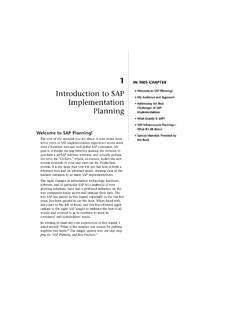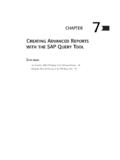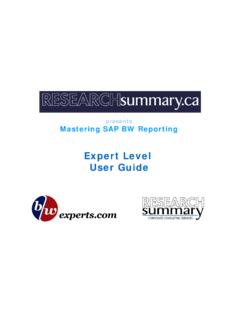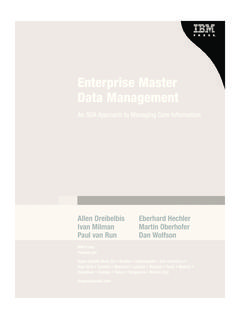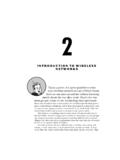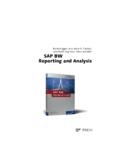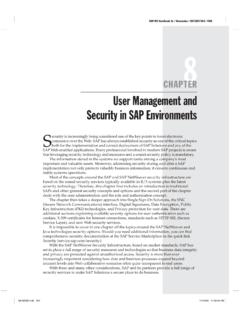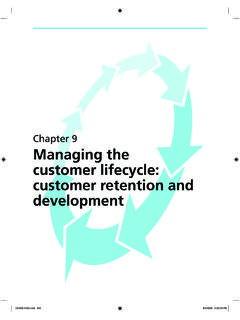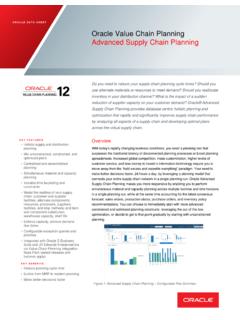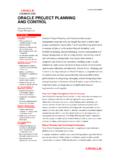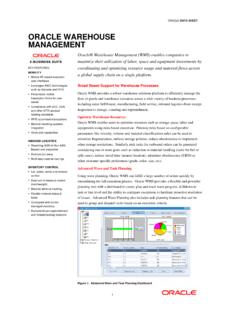Transcription of Planning Fundamentals - cdn.ttgtmedia.com
1 oracle Series / oracle E-Business Suite Manufacturing & supply chain Management / Gerald, King, Natchek / 3379-1 / Chapter 8 Blind Folio8:199 CHAPTER8 Planning FundamentalsP:\010 Comp\Oracle8\379-1\ , November 25, 2001 9:12:12 AMColor profile: Generic CMYK printer profileComposite Default screenThe oracle Applications suite currently offers two products for materialand capacity Planning in a manufacturing or distribution environment:Master Scheduling/MRP and advanced supply chain Planning . MasterScheduling/MRP offers single-organization, unconstrained Planning ofmaterial and resources. We ll use the termMRPto refer to this planningtool. advanced supply chain Planning (ASCP) is the next-generation Planning tool;it offers multi-organization Planning and the option of constraint-based andoptimized chapter describes the basic logic common to both Planning methods anddetails the common setup needed by both methods.
2 Subsequent chapters describethe unique characteristics of MRP and past releases, oracle sold a product called SupplyChain Planning , which provided the capability ofplanning across a supply chain , but without theconstraints, optimization, and variable granularity ofthe advanced supply chain product. With Release11i, this is no longer sold as a separate product, so itwill not be explicitly covered in this book. However,much of material describing advanced supply Chainplanning applies to the older supply chain Planning ;notable exceptions are the constraint and optimizationcapabilities of ASCP and the treatment of sourcingrules, which are described in Chapter Planning LogicThe basic logic of both MRP and ASCP is time tested and well documented innumerous sources.
3 Though not a comprehensive discussion of basic MRP logic,what follows is a brief overview of the process. The process is illustrated in Figure involves the recognition of demand or requirements, the netting of those requirementsagainst available and scheduled quantities, and the generation of recommendationsto meet those requirements. In a manufacturing environment, the process proceedstop-down through the bill of material, so that recommendations at one level formthe basis of the requirements on the next level of components, and so of DemandDemand initially starts as a statement of what a company expects to sell or ship. Thistype of demand represents what you know or think you are likely to sell outside200 oracle E-Business Suite Manufacturing & supply chain ManagementORACLE Series / oracle E-Business Suite Manufacturing & supply chain Management / Gerald, King, Natchek / 3379-1 / Chapter 8 Blind Folio8:200P:\010 Comp\Oracle8\379-1\ , November 25, 2001 9:12:13 AMColor profile: Generic CMYK printer profileComposite Default screenORACLE Series / oracle E-Business Suite Manufacturing & supply chain Management / Gerald, King, Natchek / 3379-1 / Chapter 8 Blind Folio8:201your company and is traditionally calledindependent demandbecause it is to someextent outside of your control.
4 In a manufacturing business, the independentdemand for your finished goods determines the demand on the component parts;this is calleddependent demand, since it depends on, and can be calculated from,your bills of demand is typically some combination of forecast and actual (SalesOrder) demand. Depending on the stocking strategy you employ for a particularproduct, the mix of forecast and actual demand will vary; in a make-to-stock strategy,you will rely heavily, perhaps exclusively, on forecast demand. In a make-to-orderstrategy, you will rely heavily on actual sales orders. Furthermore, the ratio of forecastto actual will likely vary over the time horizon, as shown in Figure 8-2 in the nearterm, you might rely most heavily on actual demand, while using forecast demandat the mid- and long-range points of the time Applications allow you to have alternate forecast scenarios, so the forecastsyou want to use to plan, as well as the actual demand you want to recognize, are statedin a Master Demand Schedule (MDS).
5 The MDS is discussed in more detail, in the Master Scheduling demand is demand calculated from the explosion of your bill ofmaterial. An important premise of MRP Planning is that you should calculate, notforecast, dependent demand. For example, one automobile requires four tires; ifyou forecast or sell one auto, you know you will need four tires to build it. There sChapter 8: Planning Fundamentals201 FIGURE netting, Planning , and explosion logicP:\010 Comp\Oracle8\379-1\ , November 25, 2001 9:12:14 AMColor profile: Generic CMYK printer profileComposite Default screen202 oracle E-Business Suite Manufacturing & supply chain ManagementORACLE Series / oracle E-Business Suite Manufacturing & supply chain Management / Gerald, King, Natchek / 3379-1 / Chapter 8 Blind Folio8:202no point in forecasting tires; you can calculate the requirements from the bill of they represent an attempt to predict the future, forecasts are notoriouslyinaccurate.
6 Forecasting what you can calculate can only compound is possible that one item can have both independent and dependent demand. Ifyou were to sell tires as service parts, in addition to including them on a manufacturedauto, you would want to forecast the independentportionof the demand on tireswhile calculating the dependent to Net CalculationOnce the demand is known, the next step is to determine how much of that demandcan be satisfied from existing stock or existing orders. It s simple arithmetic; if youhave gross requirements (total demand) for 100 units of a product, and you have 25on hand, the net requirements are makes this arithmetic a little more interesting. If that same demandwere spread out over four weeks (25 per week), your 25 on-hand would satisfy thefirst week s demand.
7 If you had an existing order ( , a manufacturing order) tobuild 25 more in week 3, the system would expect you to reschedule that order tosatisfy the demand in week 2 and would then see net requirements for 25 each inweeks 3 and and forecast demandP:\010 Comp\Oracle8\379-1\ , November 25, 2001 9:12:15 AMColor profile: Generic CMYK printer profileComposite Default screenRecommendationsIn the scenario described earlier, the Planning process would recommend that youreschedule the existing order from week 3 to week 2 and would recommend thatyou create new orders to satisfy the demand in weeks 3 and this process, Planning will respect any order modifiers you ve attached to theitem, such as minimum or maximum lot sizes.
8 It will look at any anticipated shrinkagefactors you ve associated with the product and inflate the planned orders tocompensate. And it will respect time fences to allow you to stabilize your production orprocurement schedules in the short term. It is the application of all these factors thatmakes Planning beyond the scope of paper and pencil for all but the simplest modifiers, shrinkage, and time fences are described later in this of Material ExplosionIn a manufacturing environment, once the top-level demands are known, thecomponent demands are calculated based on the explosion of the bill of component demand (plus any independent demand for the component) constitutesthe gross requirements at the next level.
9 The Planning process then continues tocalculate net requirements and plan orders at each level in the bill of CyclesYou can use oracle s Planning products in numerous ways to generate distributionplans, master schedules, and manufacturing (MRP) plans for your enterprise. Thepossibilities are almost endless, but we ll discuss two typical examples 8-3 shows the traditional Planning cycle. In this cycle, you createforecasts and book sales orders, load the selected forecasts and orders into a MasterDemand Schedule, use the MDS as input to Planning a Master Production Schedule,and submit that MPS to MRP. This cycle separates master scheduling and MRP so thatyou can firm up a master schedule before submitting it to MRP.
10 You must synchronizethese plans by carefully considering the timing of the running of each 8-4 shows aholisticplanning cycle; in this cycle there is only one planthat satisfies the needs of distribution Planning , master scheduling, and still generate forecasts, book orders, and load demand schedules, but you useone or more demand schedules from multiple organizations to generate one completesupply chain noted earlier, numerous variants of these cycles are possible. A company thatdoes not need to separate the Master Production Schedule from the MRP Plan canrun MRP directly from the MDS. Within the supply chain plan, master schedulescan be used to introduce some stability and local control into the plan. But all plansrequire some initial statement of demand, usually a combination of forecast andChapter 8: Planning Fundamentals203 oracle Series / oracle E-Business Suite Manufacturing & supply chain Management / Gerald, King, Natchek / 3379-1 / Chapter 8 Blind Folio8:203P:\010 Comp\Oracle8\379-1\ , November 25, 2001 9:12:15 AMColor profile: Generic CMYK printer profileComposite Default screen204 oracle E-Business Suite Manufacturing & supply chain ManagementORACLE Series / oracle E-Business Suite Manufacturing & supply chain Management / Gerald, King, Natchek / 3379-1 / Chapter 8 Blind Folio8:204sales orders.
